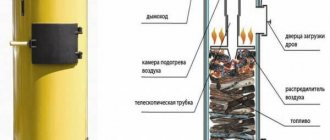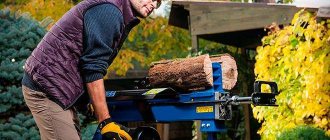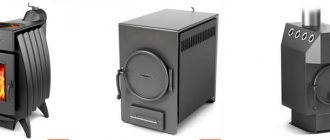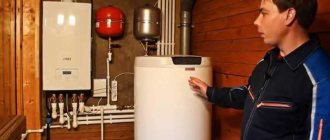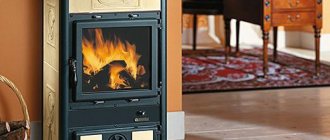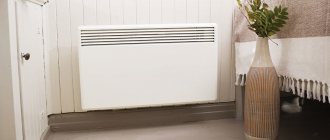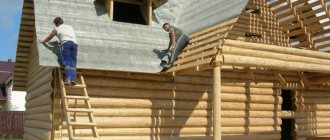Until recently, the primitive wood stove was the main source of heat in many settlements that did not have centralized heating. But progress does not stand still and today stoves are becoming a thing of the past, and their place is taken by solid fuel boiler equipment with high efficiency and the ability to automate the entire heating process.
Various designs of this type make it possible to select equipment for a small country house, a cottage with several floors or an industrial premises, and the choice of fuel type, taking into account local conditions, makes it possible to significantly reduce the cost of heat.
Power
This is an important point to consider. The calculation is made according to the formula for 10 sq.m. 1kW. But these are just approximate numbers. Two categories can be distinguished: up to 100 kW (intended for individual use), and more (used in large factories).
There must always be a reserve of power so as not to create excessive load. Thanks to this, they will work more productively and longer. Don't forget that this also depends on what is being burned in there.
Main combustion period
Conventionally, the process of how to properly heat a boiler with coal can be divided into several stages - the first ignition, the second period of main combustion, the stage of achieving stable combustion and finally, attenuation.
The main period of combustion usually occurs at the moment when the firewood forms productive coals for backfilling the stone fuel. How to properly heat a solid fuel boiler depends on when the moment of filling the first portion of fuel is chosen. In terms of time, from the moment the paper begins to burn until the logs of the main tree are engulfed in flames, it usually takes 4-5 minutes, but this is with normal draft and an open blower damper. You can check what is happening in the firebox by opening the firebox door - when opened carefully, the firebox will be illuminated with an even, bright flame, which means that the time has come to add the first portion of coal.
First, fine coal 2-4 cm in diameter is poured into the firebox. At approximately this stage you will need from 0.5 to 1 kg of fuel or 1-2 scoops. Coal is poured through the fire door and made so that its layer is evenly distributed over the entire fire area. Immediately after backfilling, the door closes, and the valve on the vent door opens slightly to increase the access of oxygen to the combustion space.
It’s worth checking what’s happening in the firebox after 10-12 minutes. This time is enough for the temperature to rise to 400 degrees and the fuel begins to burn, releasing enough heat. During this period, it is worth paying attention to the readings of the thermometer on the boiler; if the temperature rises sharply and the coolant begins to heat up better in the pipes and radiators, it means that it is time to supplement the boiler with another portion of fuel.
According to the rules of how to properly heat a boiler with coal, you need to add from 3 to 5 kg of anthracite or medium-fraction hard coal. The coals should be of average size 4-7 cm in diameter. Just like fuel, filling is done through the combustion door with a spatula or scoop. If possible, the coal is scattered over the entire area of the firebox so that the layer is about 10-15 cm (however, much depends on the size of the firebox). After the firebox door is closed, the thermostat is set and the boiler is switched to long-burning mode, when it itself regulates the opening and closing of the oxygen supply valve.
Fuel types
It is possible to use a specific type, or a combination of them (more expensive to use and maintain, but more versatile).
There are three main ones:
- Coal
- Firewood
- Pellets (fuel capsules)
In addition to them, in some situations, waste from agriculture or the woodworking industry is used.
When choosing coal, you should take into account its fraction and grade, namely, their coincidence with operating conditions. When choosing firewood, you need to focus on its moisture content - it may not suit you.
When choosing pellets, consider the material from which they are made.
Detailed installation instructions
Solid fuel units are characterized by high inertia (with the exception of pellet models) and a tendency to form condensation in the firebox. Long-term trouble-free operation of the equipment is possible subject to high-quality installation.
Masters adhere to the following sequence of actions:
- Preparing the premises (ventilation, lighting) and a platform made of non-combustible material.
- Installation of the boiler according to the project with vertical alignment of the body and maintaining the alignment of the chimney pipe.
- Construction of a thermally insulated combustion product exhaust system with a height of 5 m or more with a permissible number of turns of less than 3.
- Connection to the heating circuit (piping).
- Test run.
After installing the boiler, safety group devices are installed sequentially: pressure gauge, safety valve and air vent.
Principle of operation
Traditional. It is similar to a regular oven. Combustion in it occurs from top to bottom. It is simple and easy to maintain. It has a low cost and demands on the quality of the energy carrier; there is no need for automation.
But low efficiency (70% - 75%), systematic maintenance, difficulty in keeping the heat at the same level, regular monitoring and replenishment of fuel (enough for 3-4 hours).
Long-burning solid fuel boilers. Their mechanics are essentially similar to a match or a candle.
- This means that combustion occurs from top to bottom. They are quite independent (about five days on coal, about three days on wood), good efficiency (about 80%), they have low requirements for the energy source (it is advisable to install a controller and a blower fan), and in models that depend on electricity, the combustion process is automated.
- But the price is also high (when compared with the previous one), sometimes automation is required (and for it a connection to the network), difficulties in using it when it is not fully loaded, there is no way to reload.
Pyrolysis. They have a two-chamber structure. In one chamber, (pyrolysis) gas is obtained from the fuel, and in the other it is burned. For this choice - the most productive of all types (more than 90%), the greatest autonomy, easy pressure adjustment.
Against it are dependence on electricity, selectivity to energy carriers (for example, wood with a moisture content of more than 20% will first lead to a decrease in efficiency and then to breakdown), high cost.
What to burn, from sawdust to anthracite
Materials of plant origin are used as fuel for this type of boiler, even peat and coal are essentially plants that existed many thousands or millions of years ago.
Firewood
Firewood is a classic solid fuel; its use dates back as many years as people have been familiar with fire. Firewood from various types of wood is used for boilers; the efficiency of the heating system and its uninterrupted operation largely depend on the type of wood and humidity. As for humidity, it is clear that the lower it is, the higher the heat transfer, since energy is not spent on moisture evaporation, and the properties of various types of wood when used as fuel deserve more careful consideration.
The most suitable option is considered to be deciduous trees, among which the record holders for heat transfer are: oak, beech, hornbeam and ash; birch is not far behind, but if there is insufficient air supply to the combustion site, birch begins to release tar, which is deposited on the walls of the smoke removal system.
Hazel, ash, yew, pear and apple have proven themselves well; they split easily and burn hot, but elm and cherry emit a lot of smoke when burning. Poplar and linden, familiar to city dwellers, are not the most suitable option for a firebox; they burn well, but quickly burn out and spark strongly during the combustion process; aspen and alder are a completely different matter, which not only do not emit soot, but contribute to its burning on the walls of the chimney .
Coniferous trees are characterized by the presence of resins in the composition of the wood, which is ultimately deposited on the inner surface of the pipe; the process of deposition of resin and soot is especially relevant for boilers in which the combustion process occurs at a not very high temperature. The heat transfer of conifers is noticeably lower than that of deciduous trees.
Briquettes
This type of fuel is made from wood chips, shavings, peat, as well as agricultural waste - sunflower husks, straw, etc. Briquettes are produced by pressing, the binder is ligin - a natural mixture of aromatic polymers, no synthetic materials are used in production, so they deservedly considered a clean fuel.
Briquettes are produced in the form of a cylinder or parallelepiped; cylindrical products from some manufacturers have an internal hole along the entire length. Briquettes are not susceptible to fungal attack, have a high calorific value and are very convenient to use, as they have a low ash content of no more than 3%.
Pellets
Pellets are a granular type of fuel that greatly facilitates the task of automating solid fuel heating devices. The material for production is waste from woodworking and agricultural production - sawdust, bark, wood chips, shavings, flax waste, sunflower husks, etc. The material is processed into flour and pressed into cylinders under high pressure, the diameter of the pellets is 5–8 mm, and the length is not exceeds 40 mm. As in the case of briquettes, the binding material is a natural component – ligin.
Functional purpose
All of the above groups, in addition to their main function, can be used to heat water. The key difference between them is the type of circuit.
Based on this parameter, they can be divided into the following subgroups:
- Single-circuit - cannot be used for this, they require additional tanks;
- Double-circuit - (another name for solid fuel boilers with a water circuit) one of them is responsible for heating, and the other for the supply of hot water;
Selection rules
The choice of a solid fuel boiler is carried out taking into account several important parameters: available fuel, operating mode, boiler power and heat supply scheme.
They also take into account the type of load, whether only heating load is required or whether hot water preparation will be additionally needed. In addition, they determine the possibility of operating the unit without electricity and take into account existing flue gas removal systems and the movement of coolant along the intra-house heating circuit.
Fuel
Even the simplest solid fuel boilers can operate on various types of solid fuel from coal to pellets. The most modern boilers provide the ability to operate the unit on liquid and gaseous fuel by installing a special burner in the combustion chamber door. This allows the owner to use available fuel in the area of residence.
Russian manufacturers use the practice of installing electric heaters in solid fuel boilers to maintain heating mode in the absence of main fuel.
It should be noted that a boiler using auxiliary fuel will operate with reduced efficiency, so you need to choose a boiler taking into account the main type of fuel and the possibility of uninterrupted supply of the required energy carrier.
Heat exchanger material
All boilers are produced with two types of heat exchangers made of cast iron and steel. The first ones are the most expensive and heavy, with a service life at least twice as long as steel ones - 20 years.
They work well in environments with high temperatures and provide good heat transfer from flue gases to the heating fluid. Cast iron heat exchangers are made of collapsible sections, so they are easy to replace during repairs.
It should be noted that cast iron heat exchangers have a number of disadvantages, including the high fragility of the product. Destruction can occur due to water hammer in the heating system during start-up or when cold water gets into hot cast iron.
Heat exchangers made of steel are almost always made in a monostructure with a boiler; they are not collapsible. Despite the fact that steel metal is more ductile and is not afraid of water hammer, it is highly susceptible to corrosion, especially in the area of welds.
Such devices are not durable, they work for no more than 10 years, and if they fail, the heating unit must be completely replaced.
Energy consumption
Boiler units operating on solid fuel are divided into 2 groups:
Volatile devices that operate only when there is voltage in the mains. Typically these are systems with forced air supply and circulation of heating fluid through the heating circuit using an electric circulation pump.
Non-volatile units do not require electricity; they work with a natural system for exhausting flue gases into the atmosphere and natural coolant circulation.
Of course, the first option is the most preferable and is used in all modern boilers with high efficiency and a level of automation of thermal processes.
Fuel loading methods
- Traditional, that is, by hand. Pros: simple structure, low cost. Disadvantages - constant supervision of equipment, increased difficulty in maintaining the required temperature regime.
- Semi-automatic. It is loaded by a person, but control already lies with automation tools. Advantages: precise adjustment of the degree of heat. Flaws – the need for equipment monitoring.
- Fully automatic. There is a hopper from which the supply comes. Advantages - of all the options presented, maximum efficiency, simplified setup of all processes, long autonomy. Disadvantages - high cost, dependence on electricity, difficult operation and elimination of defects, large size.
Coolant temperature
This is of great importance, it must exceed the “dew point”. Otherwise, acid will begin to form from steam and oxidation products, which will lead to the destruction of the unit.
- If you forcibly turn off the circulation, this will lead to a temperature difference in the boiler unit and heating radiators.
- As a result, the likelihood of water hammer and deformation increases. Now about inertia. It should be remembered that in such devices maintaining a suitable heat index is problematic. This problem can be solved in several ways.
One of them is the presence of a cooler. Both external and built into the case.
Another solution is a storage tank. It increases efficiency and allows you to control heat transfer.
Buffer tank (heat accumulator)
If we exclude devices operating on granular fuel, then solid fuel boilers are characterized by uneven operation; the increase and decrease in temperature in the furnace are cyclical. In order to smooth out temperature fluctuations in the heating system, a heat accumulator (buffer tank) is used. The design is a sealed tank with a heat-insulating layer, most often cylindrical in shape.
Two or more pairs of coils (heat exchangers) are embedded in this tank, through which heated coolant from the boiler enters the tank and is distributed throughout the heating system. This scheme allows excess energy at the peak of combustion to be accumulated in a heat accumulator, so that later, when the fuel burns out, heated water can be used to maintain the set temperature. You can read more about them here.
Coolant composition
The most commonly used roles for this role are:
- Steam. Rarely used because: it heats up pipes and batteries very much, which leads to burns, difficulties in temperature control, metal parts of the structure rust. But the high rate of heating of rooms, as well as good heat transfer, make it suitable for heating a large area.
- Water is cheap, but it forms scale and causes rusting, and there is also the need for defrosting.
- Antifreeze is expensive, but it does not freeze and does not harm the entire system.
Design features
Anyone who wants to purchase such a unit must take this into account.
Loading can be frontal (mostly with a cast iron heat exchanger) and top (in these often steel).
Solid fuel boiler Sakovich W Standart 10 kW
The advantage of the boiler is a large combustion chamber and large loading doors, operating time on one load, simplicity and durability of the design, and the ability to be used in a non-volatile system. Reviews (2)
RUB 1,980 Buy
Bestseller!
Heat exchanger material
The most common:
- Steel. It has less inertia and weight, more variety of shapes, it tolerates mechanical damage better, but is susceptible to corrosion and burnout.
- Cast iron. Durable and resistant to strong heat, easier to repair, smaller in size, but low resistance to sudden temperature changes and thermal shock, less productive, much heavier.
Other options are less common.

